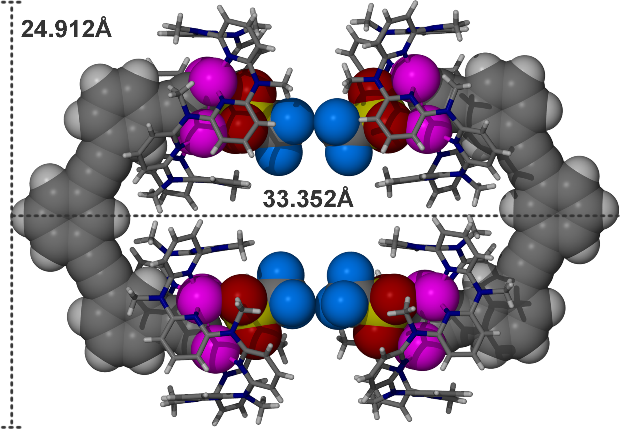 The study of metallosupramolecular complexes has emerged as an active research field and attracted intense interest in the past two decades. A plethora of two- and three-dimensional coordination self-assembled architectures were elaborately prepared by virtue of the combination of well-designed organic ligands with metal ions. These multicomponent complexes have shown a variety of potential applications, acting for example as precursors of electronic, photophysical, and magnetic materials, or used in catalysis, molecular recognition, and transport. However, in contrast to the common single metal center-based coordination self-assembly, metal cluster-centered coordination self-assembly structures were rarely reported in spite of the fact that metal clusters, an ensemble of bound metal atoms by metal-metal bonding or through electronic/magnetic interactions, usually own novel physical properties.
The study of metallosupramolecular complexes has emerged as an active research field and attracted intense interest in the past two decades. A plethora of two- and three-dimensional coordination self-assembled architectures were elaborately prepared by virtue of the combination of well-designed organic ligands with metal ions. These multicomponent complexes have shown a variety of potential applications, acting for example as precursors of electronic, photophysical, and magnetic materials, or used in catalysis, molecular recognition, and transport. However, in contrast to the common single metal center-based coordination self-assembly, metal cluster-centered coordination self-assembly structures were rarely reported in spite of the fact that metal clusters, an ensemble of bound metal atoms by metal-metal bonding or through electronic/magnetic interactions, usually own novel physical properties.
Recently, Professors Mei-Xiang Wang, Liang Zhao and co-workers in Chemistry Department of Tsinghua University reported a new method to synthesize metal cluster-centered metallosupramolecular architectures by combining anionic directing ligands with macrocyclic protecting compounds. The two cluster-centered metallosupramolecular complexes both featuring a pseudorotaxane structure with the encapsulation of an acetylide-tetrasilver aggregate into a neutral polypyridine macrocycle were fully characterized by X-ray crystallography, ESI mass spectrometry, and 1H NMR spectroscopy. This method provides a new viable means of preparing functional metal cluster-based supramolecular materials. Related work has been published on J. Am. Chem. Soc. 2011, 133, 8448-8451 (Cai-Yan Gao, Liang Zhao,* and Mei-Xiang Wang*). This work is dedicated to the centennial celebration of Tsinghua University.